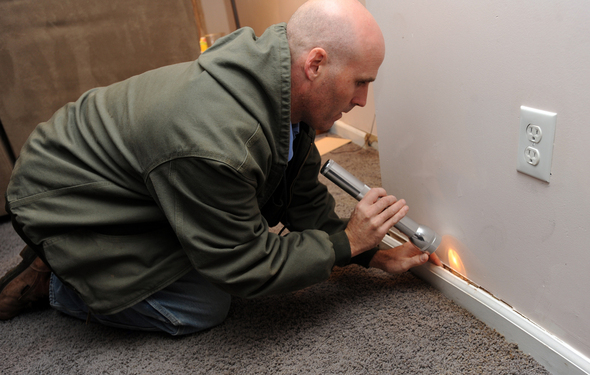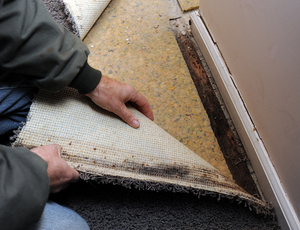Don't let mold turn your dream house into a nightmare

Mark Wilson, a mold removal expert from AdvantaClean, looks behind the baseboards in the basement of an Ann Arbor home to inspect for mold after the basement was recently flooded due to a broken water pipe.
Lon Horwedel | AnnArbor.com
Lurking inside walls and hidden in ductwork, mold can turn a dream house into a nightmare.
But Mark Wilson, owner of the AdvantaClean franchise that serves Washtenaw County, wants homeowners to take a deep breath: While mold can cause problems, it can also be cleaned up, even black mold.
And while toxic black mold (stacci botrus) is what gets the attention, it is relatively rare, Wilson said. (See Mold Myths below)
“We get calls all the time from people worried about black mold. We don’t like to scare people about it. There are thousands of types of mold and most aren’t toxic.”
Homeowners should keep an eye out for telltale signs: Water stains, a musty smell or allergic reactions such as itching or watery eyes. Anyone who has water damage should also be vigilant, Wilson said.
While mold can be a problem in any house, it’s more common in newer construction where there is a tighter seal and less air circulation.
Mold can thrive in typical places such as basements but it can also be found in crawl spaces, inside ductwork, in attics and around doors and windows.
“It likes organic materials such as wood. It loves drywall. Drywall is the perfect growing material because the gypsum holds the moisture and the paper is the mold’s food,” Wilson said.

Mark Wilson, a mold removal expert from AdvantaClean, peels back the carpet in the basement of an Ann Arbor home to inspect for mold after the basement was recently flooded due to a broken water pipe.
Lon Horwedel | AnnArbor.com
Wilson has seen nightmares, most often in foreclosed homes. A growing part of his mold remediation business (25 percent) is with foreclosed properties, he said.
As families abandon their homes, banks takeover and frequently turn off power, disabling sump pumps. Water and the sewer back up, creating a massive playground for mold to grow.
“I’ve walked into some very nice homes and the basements were completely black,” Wilson said.
There are ways to keep mold from taking hold. Outside grading should be away from the house, ventilation is important, make sure downspouts are in good repair, avoid ice dams in the winter and completely dry out water damage within 72 hours.
Mold remediation isn’t cheap. While jobs vary greatly in size, the average is about $1,400, Wilson said. He’s had small jobs that ran $200 and one job where black mold covered the entire house for $35,000.
An air scrubber with a HEPA filter is usually used to clear the air. If the mold has penetrated large areas of drywall, it’s usually removed. Cement block is scrubbed. It’s time-consuming work.
“You may have to scrub the studs, the pipes and even every wire,” Wilson said. “It’s a very detailed cleaning.”


Comments
Truth About Mold
Thu, Nov 11, 2010 : 11:14 a.m.
Mold can cause serious health problems. For accurate information about the health effects of mold and indoor contaminants, go to http://truthaboutmold.info and http://globalindoorhealthnetwork.com.
Soothslayer
Thu, Nov 11, 2010 : 8:35 a.m.
It's *stachybotrys*. Make no mistake it and it's other kindred friends usually found nearby Cladosporium, Penicillium, Aspergillus, and Alternaria have no place in any enclosed building where humans or animals inhabit and the cause (prolonged moisture) is entirely preventable. The VOC's (volatile organic compounds) and mycotoxins emitted by some of these molds during different parts of their growth phases are the same toxins that are used in bio-warfare. Exposed long enough or under the right concentrations and conditions the mycotoxins and VOC's can cause chronic respiratory & neurological damage. Resources: Short background info - http://na4mm.blogspot.com/2010/05/toxic-black-mold-be-afraid.html CDC - http://www.cdc.gov/mold/stachy.htm Cause/Effects - http://www.buzzle.com/articles/toxic-black-mold-symptoms-poisoning.html